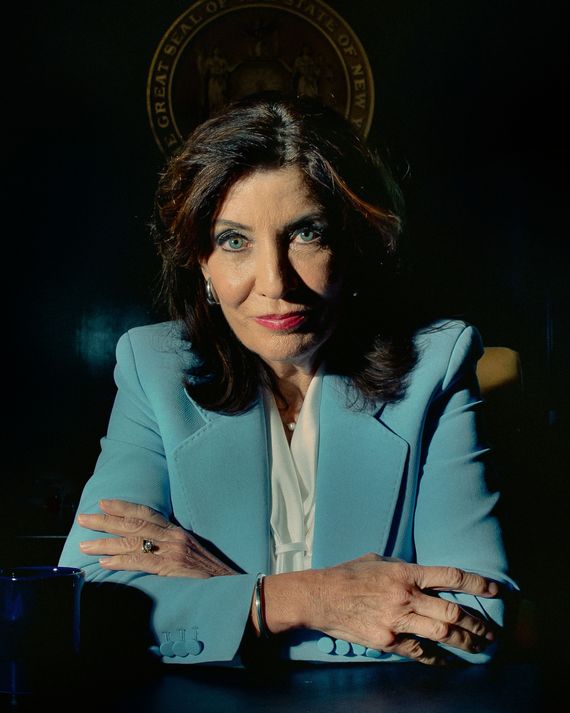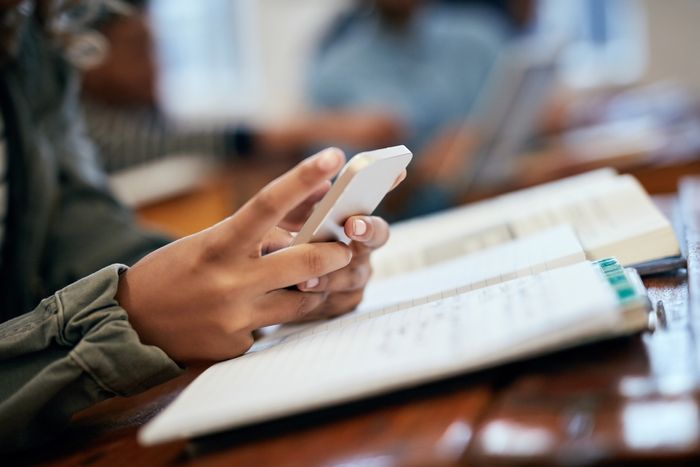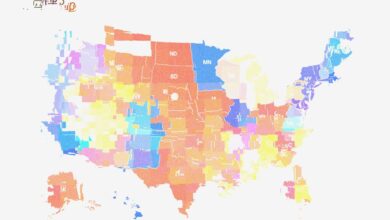

David Rounds had dismissed his class when he heard a student shouting in the hallway. “What the hell did you do that for?” the kid said. It was November of last year at Bethlehem Central High School, outside Albany. Exams and final grades loomed, as did the holidays, a time when stress tends to run high.
Rounds, who teaches U.S. history, rushed to the door. What he saw was pretty normal — some friends teasing each other. But that normality was exactly what stuck out to him. The kids were being loud again. “That’s the first day I noticed it,” he said. In the hallway, other students were standing around talking and joking in person, rather than through texting or social-media apps. To Rounds, it was the sound of success.
At the time, Bethlehem Central was about four months into a near-total ban on electronics in schools. iPhones, earbuds, smart watches, and the rest — gone. During the prior few years, when a class period would end, students would walk in near-total silence through the halls, heads down, engrossed in their phones. Surveillance cameras would sometimes capture distracted teenagers walking into a wall or even, according to Rounds, falling down stairs.
“It was really nice,” Rounds said of the ruckus that November day. “I got so used to quiet hallways the last few years. They were just staring at their phones. When it started coming back, it was noticeable. And it was awesome. It reminded me of what the hallway used to be like — a loud conversation, kids engaged with each other. And that has nothing to do with instruction, but has a lot to do, in my opinion, with the psychological state of the school.”
Before the start of the academic year, Rounds had been against the ban. Too “nanny state,” he said. “I felt the kids needed to learn self-discipline on their own.” Phones, after all, were already prohibited during class time, and most students put them in the pouches hanging near the entrance of each classroom, in accordance with the schools rules prior to the ban. “The media, at times, has overplayed how dysfunctional our students are,” he said. “You’d think our kids are zombies that have no ability to communicate, and all they do is stare at their phones 24/7. That’s not reality, and it never was.” In implementing the full ban, the school district dismissed the arguments of Rounds and other critics of the policy, including some parents. He changed his mind after witnessing the effect it had. Beyond the now-lively hallways, students’ attention stopped drifting toward the phone pouches during class time, and there was less fighting and bullying.
Bethlehem Central High School, in Delmar, New York.
Photo: Core Real Estate
Right now, Bethlehem Central is one of only a small number of New York state’s 4,411 schools to have implemented an outright ban on phones. But it may not be an outlier for much longer. For several months, Governor Kathy Hochul has been mulling a new law that would separate most students from their devices during the school day. She has been meeting with superintendents, teachers, union officials, and local politicians throughout the state to talk about how to do it.
Should a law pass — possibly as early as next year — it would be a remarkably rapid triumph for a position that was politically marginal just a few years ago. It is also a big bet on what the people — especially the parents — of New York really want from a governor whose popularity has fallen to its lowest point since she took over for Andrew Cuomo. “I pretty much know where I’m going. I believe people will come along because I know what I’ve heard, that this is probably the one bipartisan — I want to say nonpartisan — issue that really is having a breakthrough,” Hochul said in a recent interview at the governor’s Manhattan office. “I want to go big on this one. We’re going big.”
Before phones, there was another nuisance in schools — the beeper. “Telephone paging devices, known as beepers, are often used in connection with drug-trafficking and drug sales,” Mayor Ed Koch’s school chancellor, Richard Green, said in November 1988, when he announced a ban in New York City schools. Years passed, enforcement waned. By 2006, schools were flooded with smaller, more sophisticated devices, and Michael Bloomberg cracked down harder, prohibiting iPods and Blackberry phones from being present on campus. But it was a trade-off. Parents complained that they could not reach their children. Then, in 2015, Bill de Blasio lifted the ban. “Parents should be able to call or text their kids,” the former mayor said then. Smartphones were already ubiquitous among teens — about three out of four of them had one, according to Pew — and students just stored them at nearby bodegas or idling trucks for a dollar or so a day. “It was the trucks lined up outside. You would have thought it was a moving day or something,” said Gale Brewer, the longtime New York City councilmember who, as Manhattan bureau president, supported fewer restrictions on phones in schools.
Now, it looks likely that, under Hochul’s statewide policy (or possibly even a local one), NYC schools will become phone-free zones again relatively soon. In 2024, it’s hard to imagine a more popular political cause than saving the children from California tech companies. Last year, Governor Ron DeSantis made Florida the first state to ban phones from schools last year. The effect was immediate, with teachers saying that more students were engaged with class. This year, Louisiana, Indiana and South Carolina passed restrictions of their own. New York City is reportedly considering jumping ahead of the state to ban phones as early as this year. Los Angeles County has already decided to ban phones for its 429,000 students, and California governor Gavin Newsom has proposed statewide restrictions of his own. Oklahoma, Kansas, Utah, and Vermont are all weighing similar restrictions. Should all these bills pass, 19.4 million U.S. children, or about a quarter of the country’s entire population under 18, would live in states where phones are about as welcome on a school campus as a cigarette. Other states, like Ohio, Minnesota and Virginia, have also restricted phone use in schools, but stopped short of bans.
Where is their attention?
Photo: Yuri A/Shutterstock
In his book The Anxious Generation, New York University professor Jonathan Haidt argues that smartphones — as a near-constant delivery mechanism for social media’s most inflammatory comments — have been the most obvious cause of the growing levels of anxiety, depression, and suicide among teens and children. The statistics themselves are sobering. Some 95 percent of teens have smartphones. The majority of them say they are online “almost constantly.” They receive, on average, more than 250 push notifications a day. The number of girls age 10 to 14 who have died by suicide since 2010 has risen by 167 percent; those who have visited emergency rooms for self-harm rose more than 188 percent. “We live in a very intense and divisive world. How much of that spills into the psyche of our adolescents is a valid question. But I would also say that there’s never been a generation that didn’t have some intense experiences, whether it’s world wars, Vietnam, 9/11. We had the pandemic,” said Dr. Marie Wiles, the superintendent of the Guilderland School districts in New York. “But the phone is the magnifier of all things.”
There has been some dissent among social scientists about these statistics and whether phones are really to blame. The smartphone era, after all, has overlapped with the COVID pandemic, widening economic inequality, and an opioid crisis. There is no doubt, though, that the online life of teens is particularly susceptible to the kinds of angry, atomizing media that would lead teens to feel anxious, lonely, or angry. “When you’re experiencing something traumatic or dangerous or scary, your brain goes into fight-or-flight. And if the parasympathetic nervous system is in fight-or-flight for too long, you’re not going to be a healthy person,” said Julie Scelfo, founder of Mothers Against Media Addiction, a Brooklyn-based nonprofit that is trying to curb childrens’ use of phones and social media. “And social media have done that at scale.” This June, U.S. Surgeon General Vivek H. Murthy effectively put an end to the debate when he directly blamed phones and social media, and went on to urge schools to go phone-free.
Last March, Hochul visited schools around the state to talk with students, teachers, and mental-health professionals about this crisis, and has allocated millions more in funding for suicide prevention, school counselors, and other services besides just phone restrictions. Many of the students Hochul spoke with had lost parents or grandparents to COVID and been isolated from friends and family during the pandemic. “They said, ‘We’re so away from people. We are just left on our own and all we had was our devices. We tried to learn remotely and it wasn’t really working,’” Hochul said. But she also noted that they seemed distracted. At one point during her listening tour with students, she said, one detail stood out to her. “They couldn’t put the cell phone down in class settings, or in a little library,” Hochul told me. “They couldn’t detach for just a few moments, even to talk to a governor who dropped by their class. So, that to me, was rather striking.”
Out of that listening tour came two bills, both focused on social-media companies. The first, called the Stop Addictive Feeds Exploitation (or SAFE) Act, disables recommendation algorithms. Its companion bill, the New York Child Data Privacy Act, stops companies like Meta or Snap or TikTok from profiting off children’s metadata. “The intention is to stop the use of these algorithms to curate content, which are designed intentionally to keep our eyes glued to the screens longer just to sell us ads. They are designed almost like heat-seeking missiles to prey upon our insecurities and send us down really dark rabbit holes,” said New York State Senator Andrew Gounardes, who was the lead Senate sponsor for the bills. Tech giants like Google and Meta spent about $1 million to stop these bills from passing, and Julie Samuels, the CEO of lobbying firm Tech:NYC, said in a statement there was no clarity on how age verification would work. Still, in June, the bills passed with only one New York legislator voting against them. At a time when a Siena poll showed Hochul’s popularity plummeting, New Yorkers overwhelmingly supported those two anti-tech bills.
A few weeks after the social-media restrictions passed, Hochul started a new listening tour at Guilderson High School, outside Albany, to talk about the next step: banning phones entirely. “I’m focused on the dark forces of the social-media world,” she said at the start of the discussion. “That leads us to one question: How do they have all this access? Cell phones.”
Two of Anna Walston’s favorite shows are Friends and Gilmore Girls, both of which she only began watching after they had been off the air for more than a decade. “I personally would have much rather grown up at a time like that, with no phones,” Walston, who is now an incoming freshman at the University of Connecticut, said. “Everyone just called people on their home landline. People took pictures with cameras. There wasn’t any social-media drama or anything that could bring people down or affect people’s mental health. People just lived in the moment. And I definitely compare school now to TV shows from the past, because it’s drastically different.”
Walson graduated from Bethlehem Central in June, following the first year of the school’s phone ban. She is not, in her estimation, a person who is especially invested in her digital life. “Personally, I don’t get very worked up about social media. I kind of just throw it over my shoulder,” she said. Rather, she channeled her energy into basketball (she captained the girls’ varsity team, and also coached) and volleyball. She was against the school ban at first — her father, who’s on the board, voted for it — but she later came around. “I definitely think that not having my phone during my free periods, and even during my lunch, I was able to focus,” she said. “It kind of just made me and other kids focus on their schoolwork more than just sitting on their phone and watching TikTok through the whole period.”
Yondr bags are used to store devices during the day at Bethlehem Central and other schools that have banned phones.
Photo: Courtesy of Yondr
There is no written proposal yet for what Hochul’s law might look like — at least not publicly. But the eventual policy could very well make schools around the state look a lot like Bethlehem Central. At the beginning of each day, teachers and administrators check that students have their phones in secure pouches made by Yondr, which can only open with magnetized keys. Students are allowed to carry around their Yondr bags — they just can’t remove the devices until the end of the day. (There are exemptions, including for students who needed to check their blood sugar on their phones, or for emergencies.) Students caught with their phones, earbuds, or smart watches out must hand them over to an administrator at that time, and then personally check them in every morning for the next 30 days. (Any policy would likely include state funding toward Yondr pouches and other costs imposed on local school districts.) Melinda Person, the president of New York State United Teachers, an umbrella union group, said that just having a uniform statewide policy would help make it easier on teachers trying to deal with the problem of phones. “This is probably the number-one issue that comes up as I visit classrooms across the state,” she said.
Still, not everyone loves the idea. Many parents have pushed back against bans — especially around concerns about being able to reach their children. (In Scoharie County, which also enacted a ban, police and security officials told parents that smartphones are distractions during school emergencies, and could put their lives at greater risk.) “A few parents said, ‘My kids have anxiety. Them texting me during the day helps.’ But none of those concerns came to fruition at all,” Rounds said. After a short stint without their phones, he said, those students appeared calmer and better able to handle problems. “A lot of times when they were texting their parents,” he added, “their parents would feed into the anxiety and prolong it.”
The governor said that while she considered an executive order, she has since concluded that legislation would be the most effective route for enacting a ban. Hochul believes a statewide law would take pressure off school boards and superintendents to implement stricter rules at the local level. “We’re not giving the world a generation of young people who’ve had all the advantages they should have right now,” she said. “There’s something stopping that. It’s not their fault. It’s our fault, if we don’t do something about it.”
Source link







